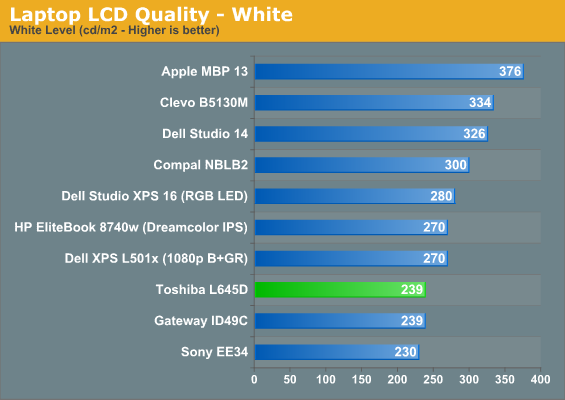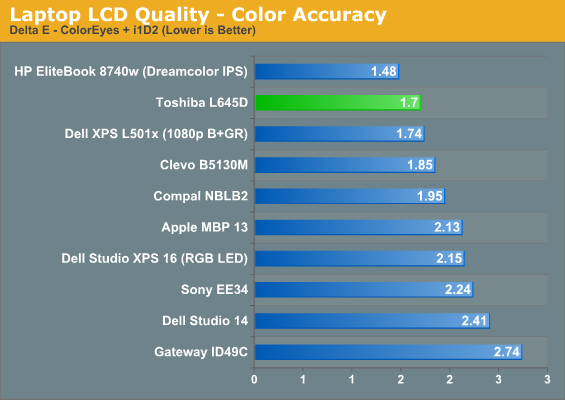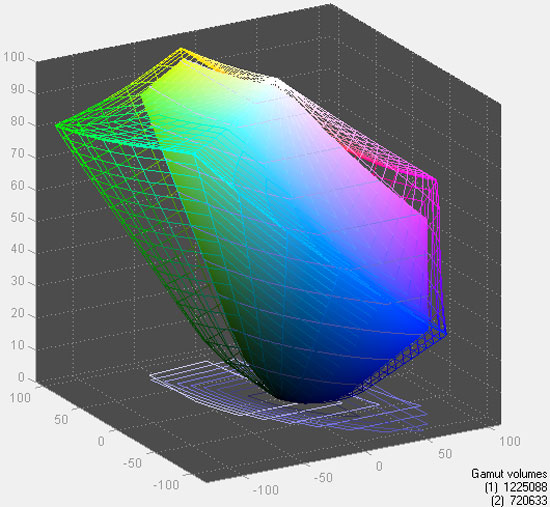Toshiba Satellite L645D: Mobile AMD at 3GHz
by Dustin Sklavos on March 9, 2011 3:20 AM ESTAt Least 720p Makes Sense Here
More and more on 15.6" notebooks, the 720p resolution feels almost idiotically low. The LCD industry must be thankful Windows XP isn't in heavy rotation anymore: between the look of Luna and the gigantic taskbar on a 15.6", 720p screen, every notebook would feel like it was shipped from Fisher Price's laptop division. At least on the L645D's 14" screen, 720p makes more sense. Keep in mind that this notebook retails for $619 when you look at our test results, though. You get what you pay for; asking for DreamColor at that price is dreaming at best—foolhardy at worst.







The L645D's display isn't great but it's not completely awful either, offering decent brightness and color gamut. What is troubling is a trend I'm noticing on more and more of these budget systems: the screen lattice and poor dithering on these cheap 720p TN panels seems to be getting more and more apparent, and it's a problem not easily captured in photos. It was most egregious on Gateway's ID49C (still our champion worst notebook screen), but has been present on both this notebook and the Sony EE34.
Viewing angles aren't great either, with massive washout at low angles and some trouble finding the "sweet spot." That problem has historically been extremely common in 14" notebooks, though, to the point where you might as well ask for a GeForce GTX 485M for how often you find a large sweet spot in this form factor.















61 Comments
View All Comments
Dustin Sklavos - Wednesday, March 9, 2011 - link
Glossy plastic looks good in photos and that's about all it's good for; using glossy plastic for the keyboard is insane.mmatis - Wednesday, March 9, 2011 - link
I no longer touch any Toshiba products. Your mileage may vary.Vincent - Wednesday, March 9, 2011 - link
I see 10/100 ethernet offered on a surprising number of notebooks. Why cripple a machine like this? I wish reviewers would criticize manufacturers for not offering gigabit ethernet.alent1234 - Wednesday, March 9, 2011 - link
almost everyone uses wifi these days, and this is a way to cut some costs on a low margin product. most people won't care about no gigabit since no one has gigabit broadband and the whole home media server thing is a tiny nicheanactoraaron - Wednesday, March 9, 2011 - link
yeah but let's face it, we're talking about a difference of about a dollar to Toshiba for the gigabit upgrade. And to say whole home media server or even media sharing is a niche in regards to a laptop with a blu-ray player seems a bit off base.piroroadkill - Thursday, March 10, 2011 - link
No. If you want to use the laptops in a small business situation, imaging over gigabit is much, much faster.Believe me, consumer laptops DO get used in small business/education environments.
Also, gigabit ethernet would cost almost nothing to add over 10/100. There's simply no reason not to have it.
piesquared - Wednesday, March 9, 2011 - link
I recently bought an Acer 5552G with one an N660, and it's a terrific notebook. It has a 6470M but I never bought it for the gaming, even though it has no problems for what I use it for. Highly recommend the processors, and i'd wouldn't touch one of those flakey sand bridge things, or whatever they're called. It's a big risk buying one of those unstable and flawed parts.Kibbles - Wednesday, March 9, 2011 - link
I'm curious as to why glossy plastic is so adamantly deemed as bad, as if it's fact. I myself prefer the ultrafine matte that's almost like a paper texture, but that's a personal preference. I'm sure there's lots of people out there that like glossy plastics. I know my mom likes it. Could it be that the demographics that these low end laptops target predominantly prefer glossy plastics? Has any manufacturer ever given any statistical feedback on this?LoneWolf15 - Wednesday, March 9, 2011 - link
The amount of crap loaded on Toshiba laptops disguised as useful software makes me avoid them. Hey, we have a separate widget for managing absolutely everything, and each one runs in a separate process that takes up additional RAM, and each one is a separate executable that takes up disk space too! Isn't that NEAT?Toshiba, a bit of advice: Look at apps like Dell ControlPoint, or even a few of Lenovo's (not as cohesive, but still better thought-out), and realize what a great service you could do your users by bundling nearly a dozen system utilities into a single, unified app. That way, the average user doesn't have to send a system to me to figure out what is useful, what is not, and why all of the stock software is sucking half a gig of RAM (on top of what the OS takes) out of the box, and thrashing the disk. Actually, you're also less likely to have a user say "I'll never buy a Toshiba again, they're ungodly slow."
KiwiTT - Wednesday, March 9, 2011 - link
After nearly 8 years since that model was released, I would have thought we would have had double or even triple the resolution in a 14" form-factor.And it is not just Toshiba, it is nearly all the manufacturers. And if you want comparable resolution to the T41, you have to pay almost double. While you may say that the new notebooks have better brighter Screens, CPUs, Graphic Cards, Battery life, etc., it seems as if screen resolution has been stuck in neutral. This is the main portal to all that is available in the notebook, so it should be the best it can be.
I think major review sites like this one and others should actually start bemoaning this lack of increase in resolution for more mainstream notebooks. Even the new ipad2 was rumored initially to have a better resolution, but no, this was false again.